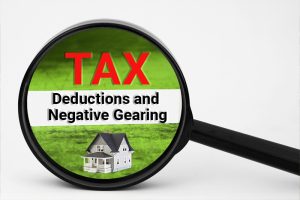
Are you an aspiring property investor in Australia seeking to capitalize on various investment strategies? Negative gearing has long been a popular and widely debated strategy among property investors. This comprehensive guide will delve into the world of negative gearing in Australia, discussing its benefits, calculations, and tax considerations for 2023 and 2024. By the end, you’ll have a solid understanding of negative gearing and how it could potentially benefit your property investment endeavors.
Key Takeaways
- Negative gearing is an investment strategy in Australia that allows investors to offset their losses against taxable income for tax savings.
- The benefits of negative gearing include potential capital growth, improved cash flow and deductions on interest, fees & expenses.
- Tax considerations should be taken into account when calculating the viability of negatively geared investments. Professional advice can help maximize deductions and reduce taxable income.
The Basics of Negative Gearing in Australia
 Negative gearing has been a prominent investment strategy in Australia for decades, particularly in the property market. In essence, negative gearing involves owning an investment property where the costs associated with its ownership exceed the rental income it generates, resulting in a taxable loss. The primary aim of this strategy is to pursue capital growth, tax advantages, and future retirement income, which can help reduce an investor’s overall income tax liability.
Negative gearing has been a prominent investment strategy in Australia for decades, particularly in the property market. In essence, negative gearing involves owning an investment property where the costs associated with its ownership exceed the rental income it generates, resulting in a taxable loss. The primary aim of this strategy is to pursue capital growth, tax advantages, and future retirement income, which can help reduce an investor’s overall income tax liability.
The opposite of negative gearing is positive gearing, where the rental income exceeds the property’s expenses, and the investor makes a profit on their property. Negative gearing has become a popular strategy in Australia’s property investment landscape, primarily because Australia’s tax system operates in such a way that people pay tax on their income, including rental income from investment properties. By utilizing negative gearing, property investors can potentially offset their investment losses against their taxable income over a financial year, ultimately reducing their taxation for that year.
We will now explore the definition and mechanics of negative gearing in more detail.
Definition of Negative Gearing
Negative gearing is a financial strategy in which the expenses incurred from owning a negatively geared property surpass the rental income, resulting in a taxable loss. This strategy takes place when the expenditure of owning investment properties exceeds the revenue they generate annually, leading to a taxable loss that can typically be offset against other income, including your wage or salary, to provide tax savings.
Investors can lower their taxable income and tax liability through the strategic use of negative gearing.
The Mechanics of Negative Gearing
The process of negative gearing involves borrowing money to invest in a property, with the aim of offsetting losses against other income for tax savings. Those who earn higher incomes can benefit from negative gearing, as it enables them to take advantage of tax deductions, potential capital growth, and enhanced short-term cash flow.
Understanding the risks, challenges and tax implications associated with this strategy is paramount.
Positive vs. Negative Gearing
 Having established that negative gearing is a strategy where the costs of owning an investment property exceed the rental income, it’s equally important to comprehend its counterpart, positive gearing. Positive gearing occurs when the rental income exceeds the costs of owning a property, thereby resulting in a profit and taxable income. In essence, positive gearing provides investors with a consistent source of income and potential tax advantages, while negative gearing offers potential tax advantages and capital growth.
Having established that negative gearing is a strategy where the costs of owning an investment property exceed the rental income, it’s equally important to comprehend its counterpart, positive gearing. Positive gearing occurs when the rental income exceeds the costs of owning a property, thereby resulting in a profit and taxable income. In essence, positive gearing provides investors with a consistent source of income and potential tax advantages, while negative gearing offers potential tax advantages and capital growth.
Both positive and negative gearing have their unique advantages and can be valuable investment strategies depending on an investor’s financial goals and circumstances. As a property investor, balancing the potential benefits and risks of each strategy along with tax implications is key in determining the best approach for your individual situation.
Positive Gearing Explained
Positive gearing is a situation where rental income is sufficient to cover all expenses associated with property ownership, including loan interest. This investment approach allows investors to generate a profit from their rental property, providing them with a consistent source of income and potential tax advantages.
Nevertheless, the main risk with positive gearing arises when the rental income fails to cover the costs of owning the property, thus resulting in a deficit.
Negative Gearing Advantages
Negative gearing provides investors with several advantages, including tax deductions, potential capital growth, and improved short-term cash flow. By utilizing this strategy, investors can claim deductions on the interest payments on the loan, depreciation of the asset, and any other expenses associated with the asset.
Additionally, negative gearing may offer the potential for capital growth if the asset appreciates in value over time, making it a beneficial strategy for long-term wealth accumulation.

Tax Deductions and Negative Gearing
 As mentioned earlier, negative gearing can provide significant tax advantages to property investors. When your property investment is negatively geared, you may be eligible for deductions based on the interest portion of loan repayments, property management fees, and maintenance costs. By claiming these deductions, investors can effectively lower their taxable income and subsequently reduce their overall tax liability.
As mentioned earlier, negative gearing can provide significant tax advantages to property investors. When your property investment is negatively geared, you may be eligible for deductions based on the interest portion of loan repayments, property management fees, and maintenance costs. By claiming these deductions, investors can effectively lower their taxable income and subsequently reduce their overall tax liability.
Understanding the tax laws related to negative gearing and the expenses eligible for deductions is vital. We will now examine these deductible expenses and ways to optimize tax benefits when employing negative gearing.
Eligible Expenses
Interest on loans, property management fees, and maintenance costs are eligible for tax deductions in Australia. Additionally, other eligible expenses may include:
- Salaries
- Wages
- Super contributions
- Repairs
- Maintenance
- Accommodation costs
- Self-education expenses (excluding the first $250)
- Travel expenses related to work
Understanding these eligible expenses is vital for property investors looking to maximize their tax deductions and overall tax savings.
Maximizing Tax Benefits
Investors can maximize tax benefits by understanding eligible deductions, maintaining accurate records, and seeking advice from a tax professional.
Calculating positive gearing involves subtracting all property-related costs (including loan interest, maintenance, and management fees) from the rental income. If the outcome is a positive figure, the property is considered to be positively geared.
Keeping abreast of tax law updates and consulting a tax professional enables investors to optimize their deductions and claim all qualifying expenses.
Find out your borrow capacity
Calculating Negative Gearing
 Calculating negative gearing can be a complex process, as it requires considering various factors such as property costs, rental income, and tax rates. However, understanding these factors and how they impact your investment can help you make informed decisions about whether negative gearing is the right strategy for your financial goals.
Calculating negative gearing can be a complex process, as it requires considering various factors such as property costs, rental income, and tax rates. However, understanding these factors and how they impact your investment can help you make informed decisions about whether negative gearing is the right strategy for your financial goals.
To aid in understanding how to calculate negative gearing, we will examine the factors to consider and provide an illustrative example of how negative gearing could lead to tax savings for property investors.
Factors to Consider
When determining negative gearing, it is essential to consider property costs, rental income, and tax rates. Property costs can have a significant influence on the profitability of a negatively geared investment, as higher property costs may result in a lower potential return on investment.
Meanwhile, rental income plays a crucial role in the calculation of negative gearing, as a higher rental income results in a greater potential return on investment, especially when rental income exceeds expenses.
Lastly, tax rates can have a considerable effect on the profitability of a negatively geared investment, with higher tax rates leading to lower potential returns on investment.
Example Calculation
Let’s consider a hypothetical example to illustrate how negative gearing can result in tax savings for property investors. Suppose an investor borrows $200,000 to purchase a rental property, paying $2,000 in loan interest payments each month and receiving $2,500 in rental income.
The investor could claim the $2,000 in loan interest payments as a tax deduction, thus reducing their taxable income. Employing this negative gearing strategy potentially allows the investor to offset their investment losses against their taxable income, effectively reducing their tax for the financial year.
Risks and Challenges of Negative Gearing
 While negative gearing can provide potential benefits to property investors, it is not without its risks and challenges. Two primary concerns associated with negative gearing are market fluctuations and cash flow management. Market fluctuations can impact property values, thereby affecting the potential for capital growth and the success of a negative gearing strategy. Meanwhile, managing cash flow is crucial for investors utilizing negative gearing, as they must cover ongoing costs and potential shortfalls in rental income.
While negative gearing can provide potential benefits to property investors, it is not without its risks and challenges. Two primary concerns associated with negative gearing are market fluctuations and cash flow management. Market fluctuations can impact property values, thereby affecting the potential for capital growth and the success of a negative gearing strategy. Meanwhile, managing cash flow is crucial for investors utilizing negative gearing, as they must cover ongoing costs and potential shortfalls in rental income.
We will now further explore these risks and challenges to better comprehend how they might influence your property investment strategy.
Market Fluctuations
Market fluctuations refer to the changes in the prices of various financial instruments over time, including property values. When the market is volatile, property values can fluctuate rapidly, making it difficult to predict the future value of a property. As a result, market fluctuations can have a significant impact on the potential for capital growth, which is a key consideration for property investors utilizing negative gearing.
To mitigate the risks associated with market fluctuations, investors should closely monitor market trends and consider diversifying their investment portfolios.
Cash Flow Management
 Managing cash flow is critical for investors using negative gearing. To effectively manage cash flow, investors should:
Managing cash flow is critical for investors using negative gearing. To effectively manage cash flow, investors should:
- Create a comprehensive budget that includes all income and outgoings related to the property.
- Set the rental income at a rate that covers mortgage payments and other property costs.
- Maintain a cash reserve to cover any unforeseen expenses or periods of vacancy.
By following these steps in property investing, investors can ensure they are able to cover the ongoing costs of property ownership and potential shortfalls in rental income.
By having a sound cash flow management plan in place, property investors can overcome short-term cash flow difficulties while still reaping the long-term benefits of negative gearing.
Seeking Professional Advice
 Considering the complexities and potential risks of negative gearing, property investors should seek professional advice before making any decisions regarding this investment strategy. A qualified financial planner or accountant with experience in real estate investments can help you navigate the intricacies of negative gearing and provide personalized guidance based on your unique financial goals and circumstances.
Considering the complexities and potential risks of negative gearing, property investors should seek professional advice before making any decisions regarding this investment strategy. A qualified financial planner or accountant with experience in real estate investments can help you navigate the intricacies of negative gearing and provide personalized guidance based on your unique financial goals and circumstances.
Alongside finding the appropriate adviser, it’s crucial to take into account the tax implications of negative gearing, keeping in mind that tax laws and eligible deductions can change over time. Let’s explore how to find a qualified adviser and the tax considerations you need to be aware of when utilizing negative gearing.
Finding the Right Adviser
To find a suitable adviser for negative gearing, seek professional advice from a qualified financial advisor or accountant who specializes in real estate investments. You can also contact firms or experts that provide services related to negative gearing, such as tax advisors or accounting firms.
When researching potential advisers, consider their qualifications, experience, and understanding of property investment and tax laws to ensure they can provide the guidance you need to make informed decisions about your investment strategy.
Tax Considerations
Considerations for negative gearing taxation include grasping the eligible deductions, planning for capital gains tax, and being aware of changes in tax law. By claiming deductions for interest payments, depreciation, and other property-related expenses, investors can effectively lower their taxable income and reduce their overall tax liability.
When planning for capital gains tax, consider the timing of the sale of the property, the amount of capital gains tax payable, and any possible tax offsets available.
Consulting with a tax professional or researching online are both viable options for staying informed about tax law changes and ensuring you are maximizing your deductions and claiming all eligible expenses.
Summary
In conclusion, negative gearing is a popular investment strategy in Australia’s property market that can provide potential tax benefits and capital growth opportunities for investors. By understanding the mechanics of negative gearing, the differences between positive and negative gearing, and the tax implications of this strategy, investors can make informed decisions about whether negative gearing is suitable for their financial goals and circumstances.
However, it is essential to be aware of the risks and challenges associated with negative gearing, such as market fluctuations and cash flow management. Seeking professional advice from a qualified financial planner or accountant can help investors navigate the complexities of negative gearing and ensure they are maximizing their tax deductions and overall investment returns.
Frequently Asked Questions

Is negative gearing a good thing?
Negative gearing can provide a significant tax benefit by allowing you to offset net rental losses against other income, resulting in a lower tax bill.
Therefore, it can be seen as a good thing for investors.
What is negative gearing in simple terms?
Negative gearing is a term used to describe borrowing money to invest in property, where the costs of owning the rental property are more than the rent returns earned.
The idea behind negative gearing is that the investor can use the losses from the investment to offset other income, such as salary or wages, and reduce their overall tax liability.
What is the problem with negative gearing?
Negative gearing leads to a negative cash flow but allows taxpayers to receive an annual tax benefit.
This benefit is lost when the capital gain from selling investments is fully taxed, reducing the attractiveness of negative gearing.
Who benefits most from negative gearing?
High income households are the primary beneficiaries of negative gearing, with the top 20% of households receiving approximately 50% of the benefit, while only 6% goes to the bottom 20%.
This demonstrates a clear inequality in the distribution of the benefits of negative gearing, with the majority of the benefits going to those who are already well off.
Is negative gearing legal in Australia?
Negative gearing is legal in Australia and allows individuals to deduct their losses from investments against other income such as salary or wages. This forms part of Australia’s personal income tax system, and can apply to all types of investments.
However, for expats who are not earning an income in Australia, the benefits of negative gearing may be limited.












